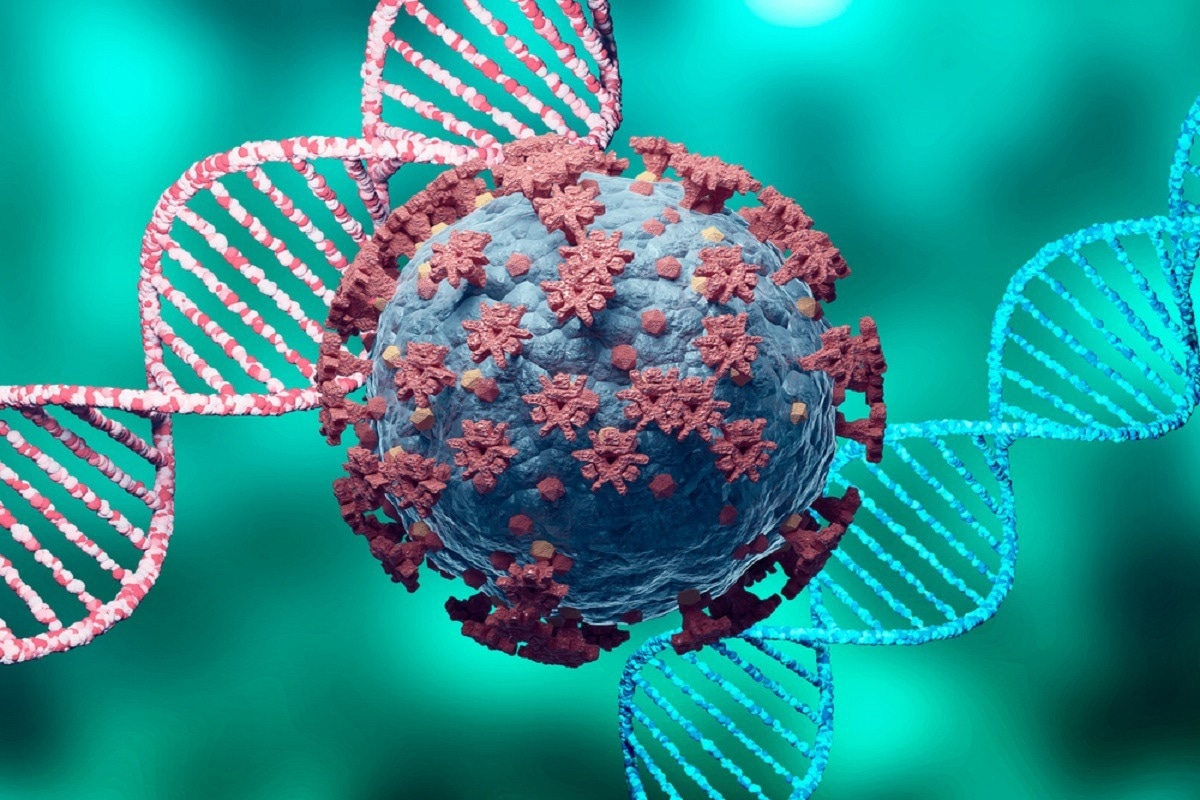Home » Health News »
Novel compound inhibits SARS-CoV-2 replication by binding a genome target
In a recent study posted to the bioRxiv* preprint server, researchers assessed the biodistribution and safety of SBCoV202, a novel antiviral agent based on antisense technology that can specifically and effectively bind to a severe acute respiratory syndrome coronavirus 2 (SARS-CoV-2) genome target to inhibit SARS-CoV-2 replication.

Background
The continual emergence of novel SARS-CoV-2 variants warrants the need for developing effective anti-SARS-CoV-2 therapeutic agents which would be safe and adaptable to novel variants. SBCoV202 is a Nanoligomer molecule comprising peptide nucleic acid sequences (PNAs) conjugated to gold nanoparticles for binding to the translation initiation site of RNA-dependent RNA polymerase (RdRp) in the SARS-CoV-2 genome to inhibit SARS-CoV-2 replication.
About the study
In the present study, researchers evaluated the safety and biodistribution of SBCoV202 in managing SARS-CoV-2 infections.
Safety and biodistribution analyses were performed using BALB/c mice who received intravenous (IV), intraperitoneal (IP), and intranasal (IN) Nanoligomer injections. The murine body weight, serum cytokine interleukin 6 (IL-6) and tumor necrosis factor α (TNF-α) levels, and histopathological changes in the liver, lung, spleen, and kidneys were assessed.
Enzyme-linked immunosorbent assays (ELISA) and a 36-plex cytokine/chemokine panel were used to measure cytokine levels. SBCoV202 biodistribution in the initial 24 hours post-administration was assessed based on the presence of gold in mice organs using inductively-coupled plasma mass spectrometry (ICP-MS) analysis,
To assess the SARS-CoV-2 replication inhibition efficacy of SBCoV202, SARS-CoV-2-infected Vero E6 cells and human lung epithelial cells expressing human angiotensin-converting enzyme 2 (A549-hACE2) were treated with SBCoV202 and the viral loads were evaluated using plaque assays at 24 hours post-infection (hpi) and SBCoV202 treatment. In addition, immunostaining analysis for the SARS-CoV-2 nucleocapsid (N) protein was performed.
The abundance of SARS-CoV-2 following treatment with SBCoV202 was assessed by measuring SARS-CoV-2 messenger RNA (mRNA) transcriptional regulatory sequence N-protein (TRS-N) in A549-hACE2 cells by quantitative reverse-transcription polymerase chain reaction (qRT-PCR) analysis. Further, surface plasmon resonance (SPR) analyses were performed to assess the SBCoV202 binding affinity to the RdRp translation initiation site of SARS-CoV-2FCV.
Results
SBCoV202 caused no outward distress, immunogenicity, or organ damage in mice, based on the body weight, serological TNF-α, and IL-6 levels, and histopathological assessments, respectively. SBCoV202 was biodistributed evenly throughout the body, with concentrations above 3.4 nM in most tissues. Additionally, SBCoV202 showed rapid urinary and renal clearance.
In the plaque assays, reductions in SARS-CoV-2 plaque forming units (PFU) were observed, and the hACE2 cell culture experiences showed dose-dependent inhibition of SARS-CoV-2 replication by SBCoV202 concentrations between 0.08 and 10 μM. TRS-N abundance correlated well with SARS-CoV-2 abundance and SBCoV202 caused a seven-fold reduction in the abundance of SARS-CoV-2 mRNA.
The SPR analysis showed that SBCoV202 was strongly bound to the RdRp translation initiation site in an anti-parallel arrangement and the binding association rate constant (ka) was 18,390 M-1s– 1. In addition, SBCoV202 dissociated slowly (dissociation rate constant kd was 6.2 × 10-5 s-1), characteristic of PNA-nucleic acid-binding.
In the ICP-MS analysis, pulmonary SBCoV202 levels after IN injections were high in the first 60 minutes, with a rapid decline in the subsequent hours, although the levels remained >3.4 nM, indicative of good SBCoV202 bioavailability. In comparison, SBCoV202 levels were lower after IV and IP injections (IN 70,000 ng/g vs IV and IP 20,000 ng/g). Further, IP administration resulted in slower SBCoV202 biodistribution and elimination than IV and IN routes of administration.
In urine, SBCoV202 levels were substantially lesser in IN-treated mice compared to IV-treated mice and IP-treated mice (IN 70,000 ng/g, IV 600,000 ng/g, and IP 350,000 ng/g). IV injections led to the greatest SBCoV202 concentration in the bloodstream (15,000 ng/g). However, the levels declined rapidly over time, whereas SBCoV202 levels were consistent in the blood after IP injections at 13,000 ng/g and reduced only after 24 hours. The findings indicate that IN injections must be preferred for pulmonary SARS-CoV-2 infections, whereas IP infections must be preferred for widespread SARS-CoV-2 infections.
Renal SBCoV202 levels post-IN injections (7,000 ng/g) were substantially lower than IP and IV injections (<60,000 ng/g). Hepatic SBCoV202 levels were low after IN injections (< 500 ng/g) in comparison to IP and IV injections (≥20,000 ng/g). SBCoV202 was found in the spleen and lymph nodes; however, the levels were lower than those in the liver and kidneys. However, serum albumin levels were not substantially reduced after SBCoV202 treatment, indicating good renal and hepatic health in SBCoV202-treated mice.
SBCoV202 also reached the brain via all three routes of administration. In the colon, SBCoV202 levels (1,000 ng/g) were lower in IV-treated mice compared to IP-treated mice (6,000 ng/g). No histopathological differences were found in tissue morphology after five mg/kg or 10 mg/kg SBCoV202 administration, irrespective of the route of administration.
Conclusion
Overall, the study findings showed that the SBCoV202 treatment was safe, non-immunogenic, and showed favorable biodistribution in the body of mice. Therefore, SBCoV202 could be considered a strong potential anti-SARS-CoV-2 therapeutic agent.
*Important notice
bioRxiv publishes preliminary scientific reports that are not peer-reviewed and, therefore, should not be regarded as conclusive, guide clinical practice/health-related behavior, or treated as established information.
- McCollum, C. et al. (2022) "Safety and biodistribution of Nanoligomers™ targeting SARS-CoV-2 genome for treatment of COVID-19". bioRxiv. doi: 10.1101/2022.07.19.500688. https://www.biorxiv.org/content/10.1101/2022.07.19.500688v1
Posted in: Medical Science News | Medical Research News | Disease/Infection News
Tags: Albumin, Angiotensin, Angiotensin-Converting Enzyme 2, Antisense, binding affinity, Blood, Brain, Cell, Cell Culture, Chemokine, Compound, Coronavirus, Coronavirus Disease COVID-19, covid-19, Cytokine, Efficacy, ELISA, Enzyme, Genome, Gold Nanoparticles, Interleukin, Liver, Lymph Nodes, Mass Spectrometry, Molecule, Morphology, Nanoparticles, Necrosis, Nucleic Acid, Polymerase, Polymerase Chain Reaction, Protein, Respiratory, RNA, SARS, SARS-CoV-2, Severe Acute Respiratory, Severe Acute Respiratory Syndrome, Spectrometry, Spleen, Syndrome, Transcription, Translation, Tumor, Tumor Necrosis Factor

Written by
Pooja Toshniwal Paharia
Dr. based clinical-radiological diagnosis and management of oral lesions and conditions and associated maxillofacial disorders.
Source: Read Full Article



